Domestic unmanned aircraft (part 3)
In the first half of the 80-x in the Tupolev Design Bureau, the development of a new multi-purpose unmanned vehicle began, which, in addition to carrying out reconnaissance missions, could strike ground targets. According to the aerodynamic scheme, the new UAV repeated well mastered Tu-141 and Tu-143. But compared to the previous generation of reconnaissance vehicles, it was a heavier product, equipped with a variety of on-board equipment - the radar and optoelectronic systems installed in the nose. The maximum speed of the device - 950 km / h. Flight range - 300 km. The UAV Tu-300 is equipped with a turbojet outboard turbojet. The launch is carried out with the help of two solid starting accelerators. For launch, it was supposed to use a modified launcher of the BP-2 “Strizh” complex. Landing takes place using a parachute-jet system.
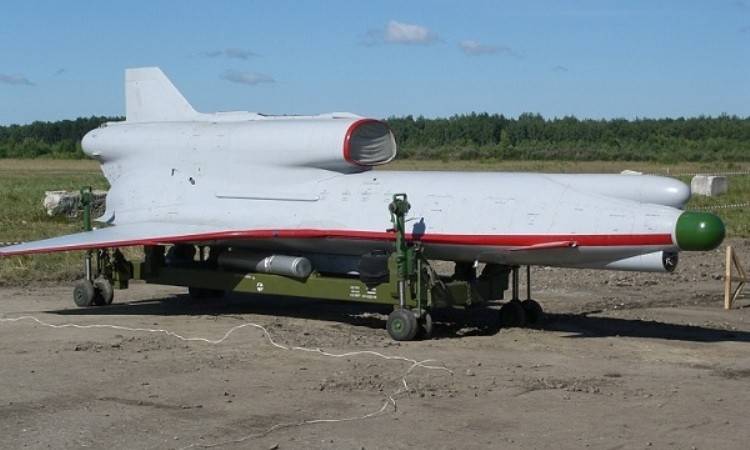
The Tu-300 Korshun-U UAV prototype, designed as part of the creation of the Stroy-F operational-tactical reconnaissance complex at the front, made its first flight in 1991. Maximum takeoff weight drone could reach 4000 kg (for retroslyator -3000 kg). The device was first demonstrated at the Mosaeroshow-93 exhibition. In addition to the shock version, the development of the Filin-1 UAV - with electronic intelligence equipment, and the Filin-2 air repeater was announced. According to the presented advertising materials, "Filin-2" was supposed to relay radio signals, flying at an altitude of 3000-4000 m for 120 minutes.
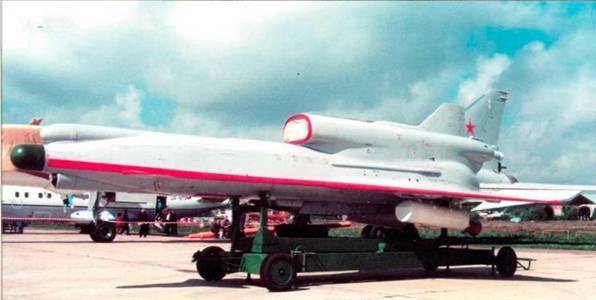
On the shock modification, there is an internal cargo compartment and a suspension unit at the bottom of the fuselage, where various aviation weapons or containers with cameras, infrared equipment and side-view radars with a total weight of up to 1000 kg. Mobile points for remote control of vehicles, a processing and decoding point for intelligence data were made on the basis of an army truck ZiL-131. However, due to financial difficulties in the mid-90s, work on the Tu-300 was frozen. In 2007, the Tupolev company announced that the achievements gained during the creation of the Tu-300 UAV will be used to create a new generation heavy reconnaissance and strike drone.
Along with medium and heavy unmanned aerial vehicles in the 80s of the last century in the USSR, as part of the creation of the Stroy-P aerial reconnaissance complex, remotely controlled drones light class, designed to conduct visual reconnaissance in real time and adjust artillery fire. To a large extent, the motivation for the development of Soviet mini-UAVs was the successful experience of using such drones by the Israelis in the early 80s during the military campaign in Lebanon. However, in the course of work on the creation of an efficient small-sized apparatus, the developers encountered numerous difficulties. For a drone with a very dense layout, where every gram of weight mattered, the dimensions and power consumption of electronic components played a huge role. Many electronic components produced by the Soviet industry were inferior to Western counterparts in terms of performance, weight and dimensions. At the same time, a number of important components of a small-sized drone had to be created from scratch.
The first flight of the prototype RPV "Bumblebee", created in the Design Bureau. A.S. Yakovlev, held in 1983 year. The device was equipped with a piston engine П-020 with power 20 hp. Of the 25, the 20 launches were considered successful. For the exploration of the area was supposed to use the camera and the transmission channel of the television signal. In 1985, the development of the improved Shmel-1 RPV with a four-bearing chassis was launched. Flight testing of a drone with a replacement set of television or infrared equipment began in April 1986. The device was stored and transported sealed fiberglass container folded. For the launch, it was supposed to use a mobile unit created on the basis of the BTR-D. Landing was carried out using a parachute with a shock-absorbing inflatable bag, reducing the impact on the earth's surface. During the tests and fine-tuning until September 1989, we managed to make 68 flights, of which 52 were successful.
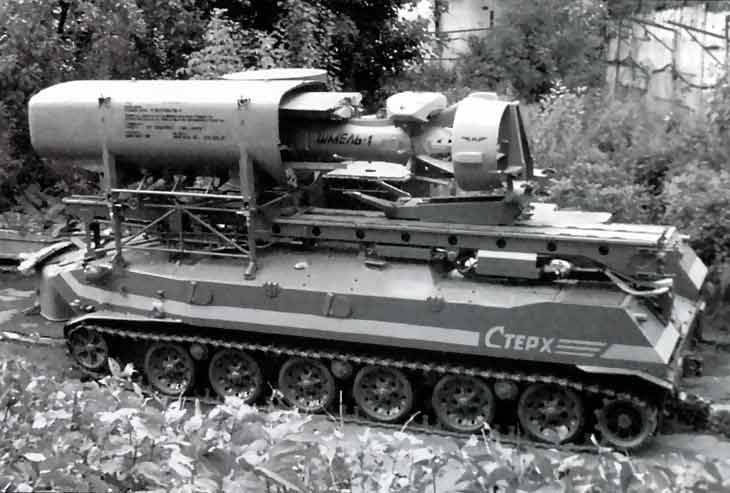
But, apparently, the test results were not too encouraging, because on the basis of the Bumblebee-1 RPV, they decided to create a Bee-1T with a P-032 two-stroke piston engine. The motor rotates the pushing screw of constant pitch, located in the ring of feathers. P-032 piston engines were produced before the 1991 year at the SNTK named after ND Kuznetsova. Total built a little over 150 instances.
The launch of the Pchela-1T UAVs was carried out using solid-fuel boosters from a mobile launcher based on the BTR-D amphibious armored personnel carrier. The complex includes a ground control station on the basis of GAZ-66 and two technical support vehicles. One control point could simultaneously control two devices. In addition to the reconnaissance modification, it was planned to create a jammer that suppresses VHF radio stations within a radius of 10-20 km.
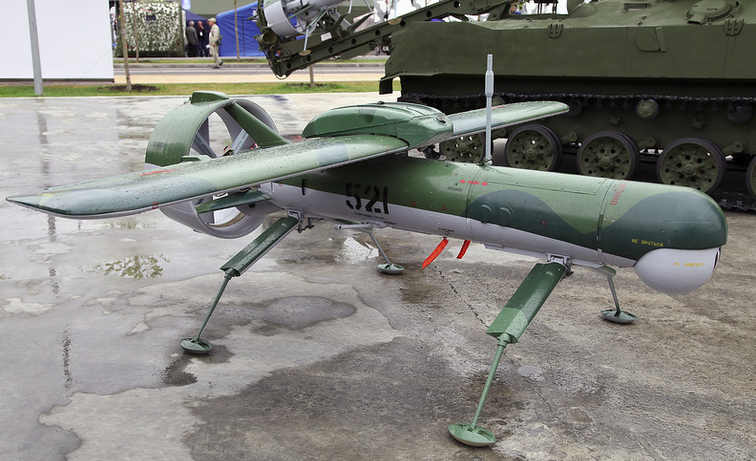
The first flights of the lightweight remotely piloted apparatus "Bee-1T" began in the 1990 year and were very difficult, because the control equipment was unstable. On tests, a drone weighing 138 kg, with a wingspan of 3,3 m and a length of 2,8 m, was able to develop a maximum speed of 180 km / h, cruising speed on the route - 120 km / h. The maximum altitude is up to 2500 m. The altitude range of optimal reconnaissance: 100 — 1000 m. The device could stay in the air for 2 hours. The operational resource is 5 departures. Warranty period - 7,5 years.
Combat tests of an unmanned reconnaissance complex with a RPV "Bee-1T" took place in 1995 in the North Caucasus. In total, 5 vehicles that made 10 sorties, including 8 combat vehicles, were involved in the tests. Time spent in the air was 7 hours 25 minutes. The maximum distance of the drone from the ground control station reached 55 km, flight altitude: 600 - 2200 m. During the combat tests two vehicles were lost. Some sources say that they were shot down by militants during a mission, others claim that the drones crashed during launch due to engine failure.
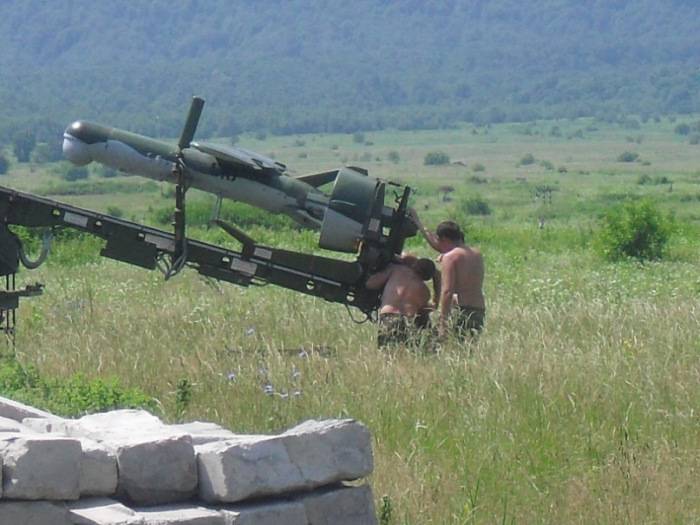
During the tests in combat conditions revealed some shortcomings. The P-032 engine turned out to be quite capricious when used in the field, this was especially apparent during re-launches. In addition, a two-stroke motor without a silencer was heavily unmasked by a remotely controlled vehicle flying at a low altitude, with the result that the drones on the route were repeatedly fired upon by militants from weapons. The image obtained from an unstabilized camera with a pitch field of view - 5 ° - -65 °, because of the vibration transmitted by the engine to the body of the device, trembled strongly, and it was difficult to see small objects against the background of the earth. In most cases, the black-and-white image was not of high quality due to the low sensitivity of the camera. As a result, the military estimated the capabilities of the Stroy-P unmanned reconnaissance complex low. However, after some refinement and re-ground tests in 1997, the complex was put into service. On the basis of the RPV, it was also planned to develop a radiation intelligence officer and an unmanned target. In 2001, state tests of the Bee-1IK modification were carried out. On board the drone experienced IR camera, providing intelligence and observation of the terrain at night and at low light levels.
At the beginning of the 2000-x, work was underway to create more sophisticated reconnaissance unmanned systems "Stroy-PL" and "Stroy-PD", with improved operational and flight-technical characteristics and great capabilities of the RPV. According to information published in the Russian media, in 2010, the tests of the Stroy-PD unmanned aerial reconnaissance system with the upgraded Pchela-1TV and Pchela-1C unmanned aerial vehicles were successfully completed.
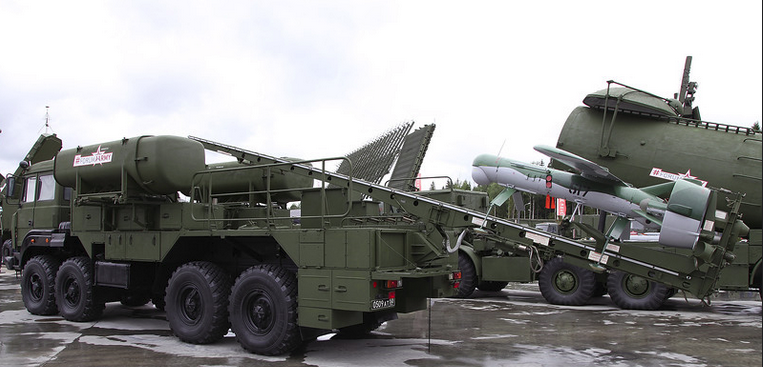
Transport and launcher TPU-576 from the structure of the complex "Stroy-PD" with DPLA Pchela-1K
As part of the “Stroy-PD” complex, a launch vehicle TPU-1 chassis “Ural-576” and a ground control station based on “Ural-532362” will be used to launch and maintain and service the RPV Pchela-375K.
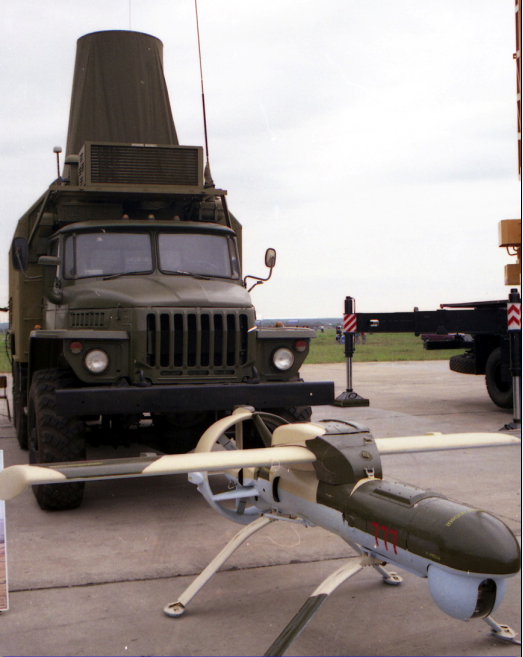
In 2005, there was information that, as part of the state defense order, the Smolensk aircraft factory began mass production of RPV "Pchela-1K". Statewide, one set of ground equipment of the Stroy-PD complex should have 12 unmanned aerial vehicles. According to The Military Balance 2016, the Russian Army had a small number of Stroy-PD complexes with Pchela-1K drones. According to information published in Western sources, in 1994, a batch of ten Bee RPVs with a ground equipment complex was sold to the DPRK.
If in the 60-80-ies, the Soviet unmanned vehicles of the middle and heavy class in general corresponded to the world level, then after the collapse of the USSR, our country is far behind in this area of aircraft industry from other technologically advanced countries. There were many reasons for this. Against the background of lack of funding, lack of understanding of priorities and the ongoing "reform" of the armed forces, the unmanned direction was on the margins. In addition, a significant part of the generals, thinking the realities of yesterday, considered compact drones to be expensive toys unsuitable for use in real combat operations. In fact, the possibility of RPVs are large enough. For example, seeing a picture transmitted from the side of an unmanned vehicle, one can effectively control long-range artillery fire, immediately making corrections, control the enemy’s communications, and issue target designation of his aircraft. In many ways, RPVs can replace the actions of ground reconnaissance groups, increase the speed of obtaining and reliability of information that is necessary in modern combat for making timely decisions. However, in addition to the banal lack of money and inertia of the top military leadership, due to the loss of a number of key technologies and the destruction of industrial cooperation, the transfer of strategic enterprises into private hands and the termination of many promising research programs, the creation of truly effective UAVs in our country has become very problematic.
It should be understood that to create a modern military UAV, you must:
1. A perfect element base for creating very light, compact elements of avionics and high-performance computing systems.
2. Economical small-sized aircraft engines designed for installation on small aircraft, which also have a significant resource and high reliability.
3. Lightweight and durable composite materials.
As is known, the Soviet Union was not a leader in all these areas at the time of its collapse. And in the “new Russia”, these areas were completely evolving according to the residual principle. In addition, if a light class unmanned vehicle can be remotely controlled via radio, then for a medium and heavy class UAV it is necessary:
1. Satellite constellation of real-time communication and control system.
2. Ground mobile control posts equipped with modern means of communication and automated workstations based on PVEM.
3. Algorithms for data transmission and control, including those that ensure the implementation of elements of "artificial intelligence".
A serious lag in these areas has led to the fact that in our country there are still no serial reconnaissance-strike UAVs capable of comparing with the MQ-1 Predator UAV, whose operation began in the 1995 year. Approximately 10 years ago, our military realized it, but to quickly catch up with the lag of two decades, even with the allocation of significant financial resources, it was impossible. Thus, according to a statement made in April 2010, Deputy Defense Minister V.A. Popovkin, the Defense Ministry of Russia unsuccessfully spent five billion rubles on the development and testing of domestic unmanned aerial vehicles. In this regard, simultaneously with the development of their own projects, UAV purchases began abroad. In recent years, a significant number of lightweight unmanned vehicles have been developed in Russia. In order not to overload the review with superfluous information, we will consider only samples adopted for service in the Russian security agencies, as well as some promising models.
The company “ENIKS” (Kazan) in the 2005 year began the low-volume assembly of the Aileron-3CB vehicles used in the mobile wearable reconnaissance complex. The device, built according to the “flying wing” scheme, with an electric motor, has a take-off weight of 4,5 kg and is launched using a rubber damper or a beam-type starting device with an air gun. The device is able to be in the air up to 2-hours and fly at a speed of 70-130 km / h in the altitude range 50-4000 m.
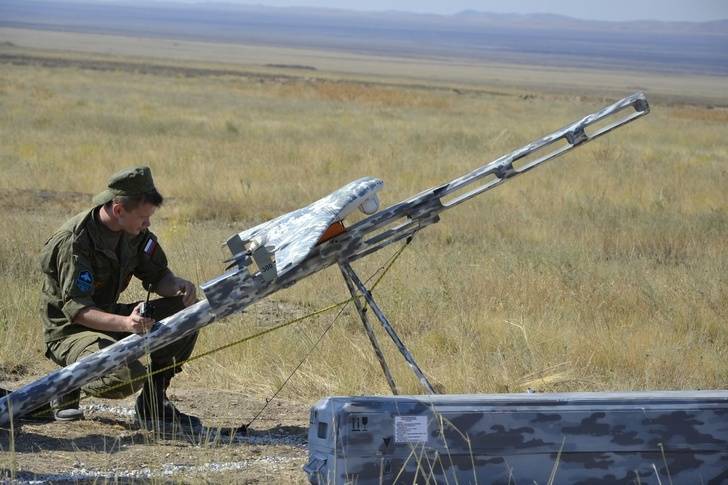
The “Eleron-3SV” type RPV is intended for conducting close reconnaissance at a distance of up to 25 km, in the interests of the first-tier military units operating in isolation from the main forces. As a payload can be used television, thermal imaging and cameras, laser designator, meteorological probe, transmitter radio interference VHF range. The payload mass is up to 800. According to the information provided on the website of the manufacturing company, more than 2005 RPVs were supplied from the Russian Army, Ministry of Internal Affairs and Federal Security Service of the Russian Federation 110.
In the autumn of 2008, the Dozor-4 RPV was tested at a border outpost in Dagestan. The Dozor complex is located on the chassis of an all-terrain vehicle. The complex includes a mobile ground control station and a vehicle in which the aircraft is transported in a special container in semi-assembled form, as well as fuel and lubricants and spare parts. Time of deployment and preparation of the complex for flight - no more than 45 min. Takeoff and landing are carried out using wheeled chassis on unpaved areas.
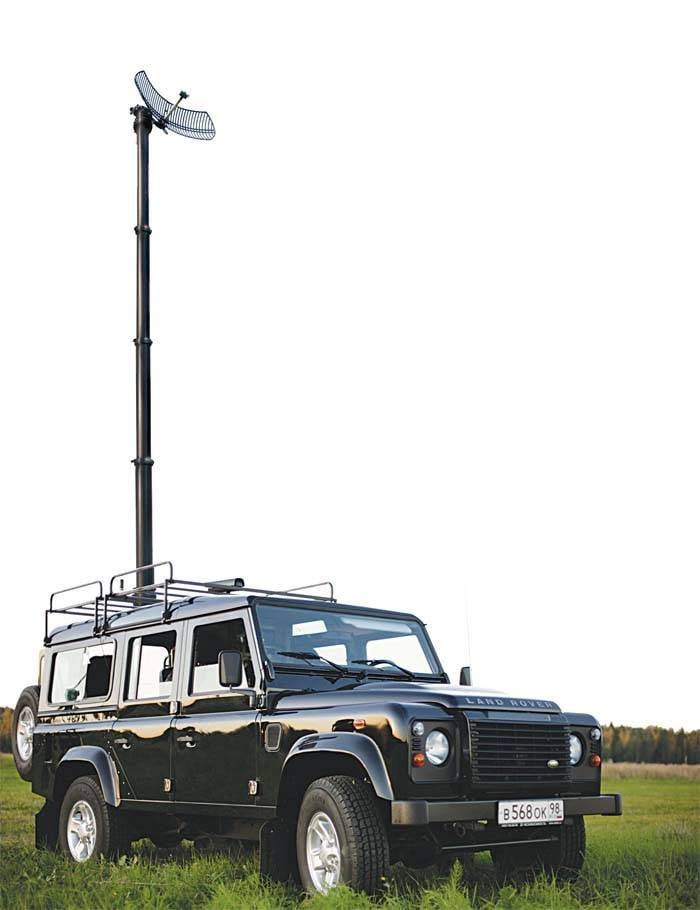
Unmanned vehicle "Dozor-4" is built according to the normal aerodynamic configuration with a twin-beam fuselage and a pusher propeller. It has two-tail vertical tail with horizontal stabilizer. The wing and tail assembly are assembled and installed immediately before departure. The plastic screw is driven in rotation by a German-made 3W 170TS two-stroke internal combustion engine. Power of the two-cylinder engine - hp 12 Engine weight - 4,17 kg.
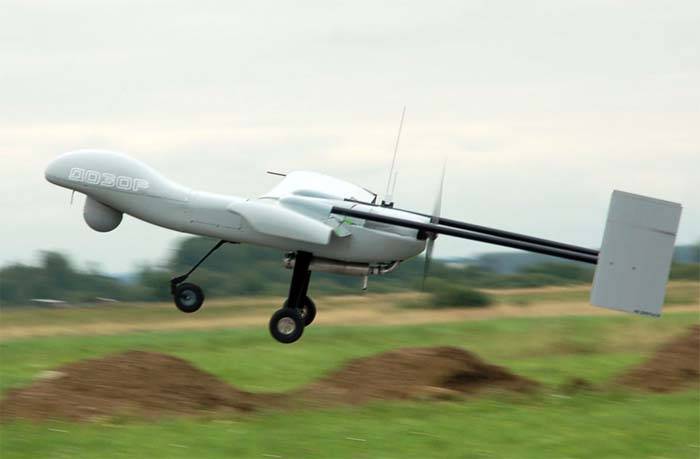
The unit with a wingspan of 4,6 m and a length of 2,6 m has a take-off weight of 85 kg. It is reported that the "Watch-4" is able to reach speeds up to 150 km / h and hold out in the air for 8 hours. Maximum flight altitude - 4000 m. Maximum payload weight - 10 kg. To conduct reconnaissance on the flight route, a television camera with a resolution of 752 x 582 pixels, a digital camera 12 Mpiks and a thermal imager are used.
At a distance of direct visibility, “Dozor-4” is controlled by commands from a ground point with simultaneous transmission to the control point of a picture from a drone board. At loss of support by the operator the autonomous control system with flight on the set route joins. The UAV navigation is performed by the commands of the small-sized inertia navigation system and the GLONASS / GPS receiver signals. The total route can be up to 250 control points. On the autonomous leg of the flight, information is recorded on the onboard drive.
In 2008, the Tipchak multipurpose complex created at the Rayx Design Bureau in Rybinsk was brought to a condition suitable for adoption.
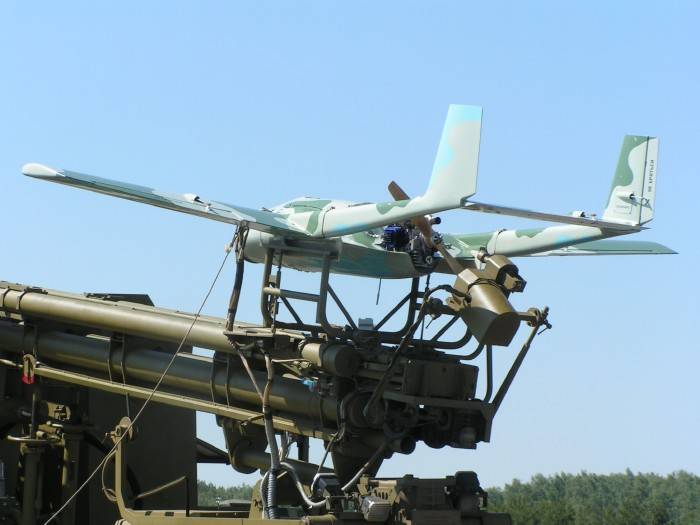
UAV-05 drone with 60 kg take-off weight is able to conduct reconnaissance in 40-60 radius km from the ground control station, in the range of flight speeds 90-180 h / h and at the height 200-3000 m. Flight duration - 2 h. Device length 2,4 m has a wingspan of 3,4 m and is capable of carrying a payload mass 14,5 kg. The launch of the UAV is carried out with the help of a solid-fuel accelerator, and the landing with a parachute.
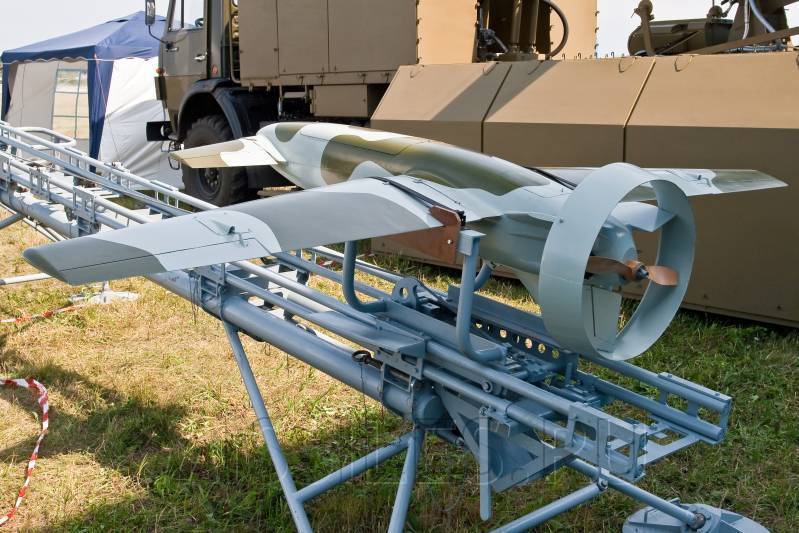
In addition to the UAV-05 UAV, a UAV-07 with a take-off weight of up to 35 kg and a range of reconnaissance - up to 50 km. Payload - 10 kg. The built-in equipment of the BLA-05 devices includes TV / IR cameras and a high-resolution digital camera. The payload may also include: radio relay equipment, jamming, and radiation-chemical and radio intelligence.
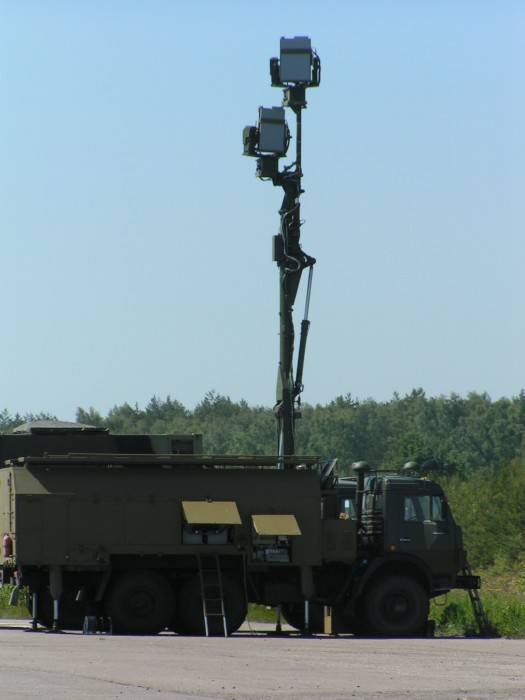
In addition to the remotely controlled vehicles, the complex includes a transport-launch vehicle, a technical support vehicle, a mobile control station with a retractable antenna post, and up to 6 RPA units.
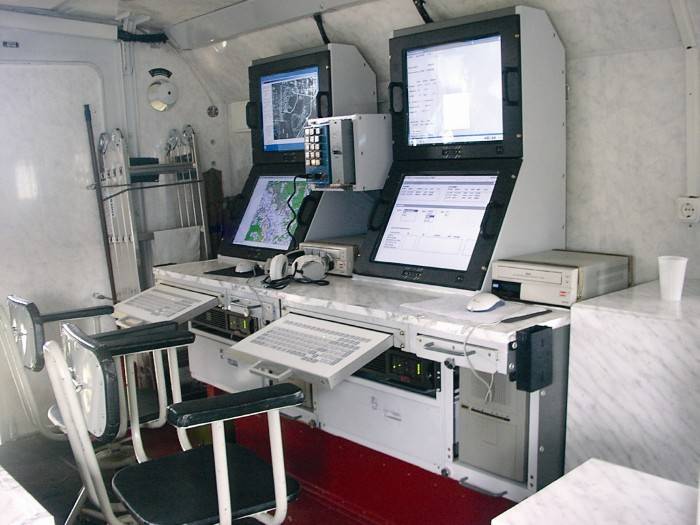
The serial production of the Tipchak unmanned vehicle elements by order of the Defense Ministry of the Russian Federation was carried out at the enterprises of the Vega concern. According to its purpose, Tipchak is similar to the Stroy-PD unmanned reconnaissance complex, but it has the best capabilities.
In 2009, the remote control unit ZALA 421-04M, created by Zala Aero Unmanned Systems, entered into service with a number of Russian law enforcement agencies. A color video camera stabilized in two planes with an overview of any point of the lower hemisphere, with a smooth change in the angle of the field of view or a thermal imager on a gyro-stabilized platform, is installed on the 5,5-mass drone. ZALA 421-04M is a mini-UAV, built according to the “flying wing” scheme with a pulling propeller, rotated by an electric motor that runs on rechargeable batteries. Thanks to the use of an electric drive, the device does not unmask itself with the sound of engine operation.
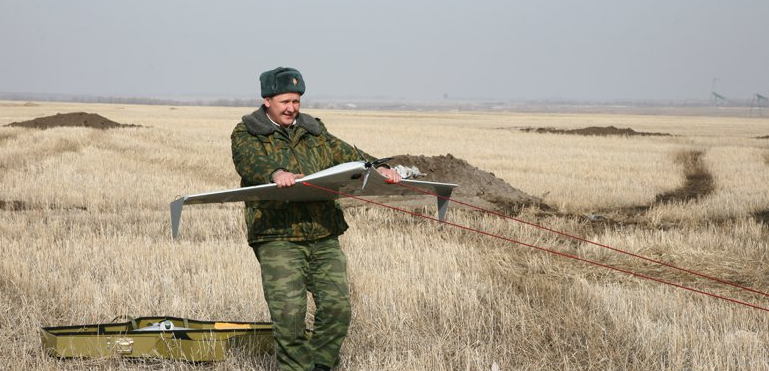
The launch of the device is carried out with the hands using an elastic catapult and does not require a specially equipped runway and bulky equipment. Descent after the assignment is carried out using a parachute. Receiving information from the drone and issuing commands to it occurs through the control unit, implemented on the basis of a special-purpose notebook, coupled with a compact portable telecontrol station. During the flight, the crew drone and the exchange of information are carried out through a rotating directional antenna mounted on a tripod.
Almost simultaneously with the ZALA 421-04M RPVs, security forces began purchasing equipment of a similar class Irkut-10. According to the datasheets submitted by Irkut Corporation, the device with a maximum take-off weight of 8,5 kg is equipped with an electric motor with a pusher propeller. When creating a UAV built according to the “flying wing” scheme, composite materials are widely used, which provide high strength with a relatively small mass. If necessary, quick assembly and disassembly is possible without the use of special technical means, which facilitates maintenance and repair in field conditions.
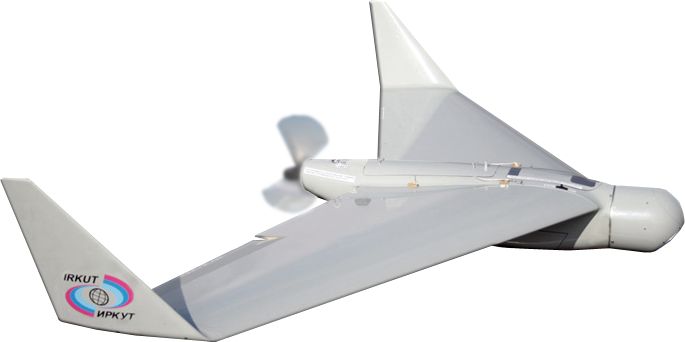
The complex consists of two RPVs, ground-based maintenance and control facilities. The launch of the UAV is carried out from a portable catapult, landing is carried out with the help of a parachute on unequipped ground sites.
In parallel with the creation of domestic light unmanned aerial vehicles, foreign-made drones were procured. After becoming acquainted with the Israeli mini-UAV IAI Bird Eye 400, it was decided to establish its licensed assembly at the Ural Civil Aviation Plant JSC in Yekaterinburg. The Russian version received the designation "Zastava". In 2011, the Ministry of Defense of Russia entered into a contract with UZGA for the supply of 2011 complexes with 2013-27 with mini ZPADA of the Zastava type with a total value of 1,3392 billion rubles.
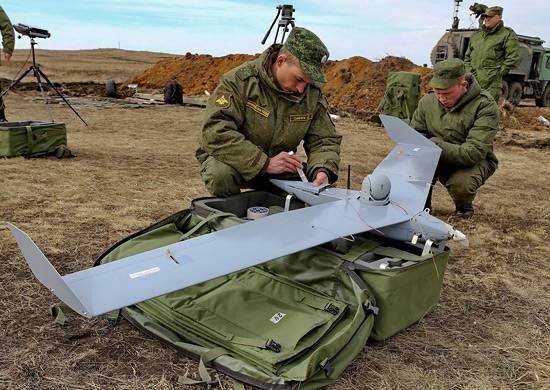
According to this contract, the Israeli side handed over the necessary technical documentation, technological equipment, test and test benches and training complexes. Israel Aerospace Industries Ltd also supplies components and assemblies and conducts training of UZGA technical personnel. The production technology of the UAV conforms to requirements of the Russian regulatory and technological documents.
The unmanned IAI Bird Eye 400 (Bird Eye) was created by the Israeli company IAI in 2003. The entire unmanned reconnaissance complex is placed in two backpack-container and can be effectively used by special forces. Tests of the first RPV "Zastava" took place in December 2012.
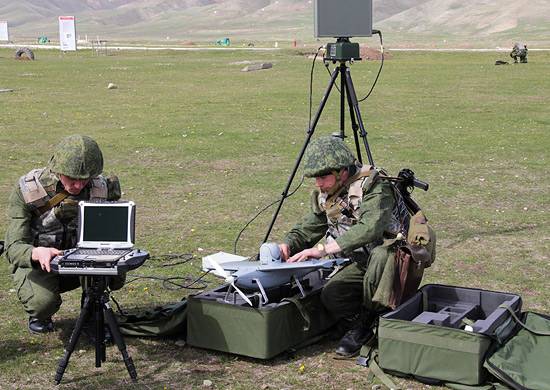
A lightweight vehicle weighing 5,5 kg, a length of 0,8 m and a wing span of 2,2 m carries a payload of 1,2 kg. The miniature electric motor provides the Bird Eye 400 with a flight time of about one hour, a range of 10 km and a flight altitude of about 3000 m. The maximum flight speed is 85 km / h.
Despite the small size of the payload, the mini-UAV is equipped with a very effective system of reconnaissance and surveillance Micro POP, which is built on the principle of "open architecture" and allows for a few minutes to replace the day TV camera with a thermal imager.
The structure of the "two-cut" complex, serviced by a two-person calculation, includes three RPVs, a portable control panel, a set of target optoelectronic equipment, a communication complex, power sources and a repair kit. The launch of the UAV is traditional for devices of such mass and dimension using a rubber shock absorber, and landing on a parachute.
Apparently, the unmanned reconnaissance system with the Zastava RPV was used in south-eastern Ukraine. According to statements made by the Ukrainian military, two UAVs were shot down in an armed conflict zone in the 2014-2015 years.
In the framework of the R & D "Navigator-2" LLC "Izhmash" - Unmanned systems "to 2010 year created a family of UAVs" Granat ". In total, four types of unmanned vehicles were tested, differing in payload composition and combat use range: 10, 15, 25 and 100 kilometers. According to available information, the Granat-2012 UAV was the first of this family in 2 to be launched into mass production.
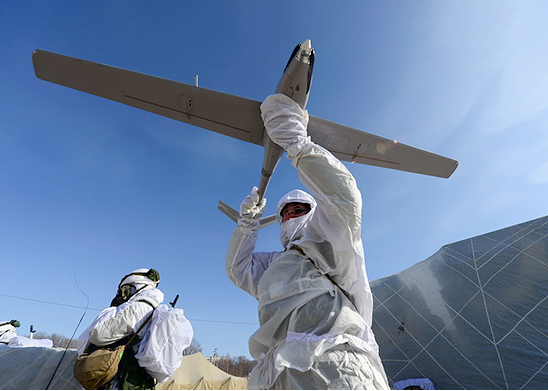
The unit weighing 4 kg is equipped with an electric motor and has a fairly compact dimensions. With a length of 1 meter 80 centimeters wingspan of this air tool is 2 meters. Relatively small size allows you to run the drone with the hands, without using special launch devices. Landing is made by parachute method. The maximum flight speed is 85 km / h, cruising - 70 km / h. Duration of reconnaissance - 1 h. Maximum flight altitude - 3000 m. Working height - 100-600 m. The onboard equipment includes photos, video and thermal imaging equipment. The complex consists of two RPVs, ground control station, spare parts for UAVs and ground equipment. Calculation - 2 person.
Due to the low cost, unpretentiousness and ease of operation, RPG "Granat-2" is very common in the Russian armed forces and is currently a regular means of artillery reconnaissance, adjusting the fire of the barrel artillery and the MLRS. UAVs such as "Pomegranate-2" performed well in combat operations in the south-east of Ukraine and in Syria.
Unmanned aerial vehicles “Granat-4” are intended for reconnaissance and correction of artillery fire and multiple launch rocket systems at a distance of up to 100 km (subject to being in a visible range). To ensure communication with the RPV at a large distance from the ground control station, a retractable antenna mast device is provided in the equipment based on the KamAZ-43114 vehicle. The Granat-4 complex includes: two RPVs, two sets of interchangeable payload modules (TV / IR / EW / photo), a complex of ground-based controls. In addition to visual reconnaissance and adjustment of the actions of artillery systems, there is a set of radio equipment that allows you to accurately find the signal of high-frequency radio emission.
The remotely piloted unit weighing 30 kg is equipped with an internal combustion engine with a pushing screw, and can carry a payload weighing up to 3 kg. The 3,2 m wing span is capable of floating in the air for 6 hours. Patrol working height - 300-2000 m. Ceiling - 4000 m. Maximum speed -140 km / h. Patrol speed - 90 km / h. Starting the device - with a catapult. Return - on a parachute. To prepare the drone to launch takes 15 minutes.
As of 2014, the Russian Army had about three dozen complexes with the Granat-4 drones. They participated in hostilities in the Syrian Arab Republic and in the south-east of Ukraine, having established themselves as simple and reliable in operation, demonstrating the ability to perform a wide range of tasks. Modern equipment installed on the "Granat-4" RPV allows for visual and radio reconnaissance day and night.
In 2012, military trials of the reconnaissance unmanned aerial vehicle "Takhion" began, from the company Izhmash - Unmanned Systems. RPV is built on an aerodynamic scheme "flying wing". When creating this drone, account was taken of operating experience in the troops of other small-class drones. Tachyon equipment is capable of functioning in adverse weather conditions, in the temperature range from -30 to + 40 ° C, and with gusts of wind up to 15 m / s. An apparatus with an electric motor has a take-off weight of 25 kg. Length - 610 mm. Wingspan - 2000 mm. Payload - 5 kg. Maximum flight speed -120 km / h, cruising - 65 km / h. The device is able to stay in the air for 2 hours and conduct reconnaissance at a distance of 40 km from the launch point.
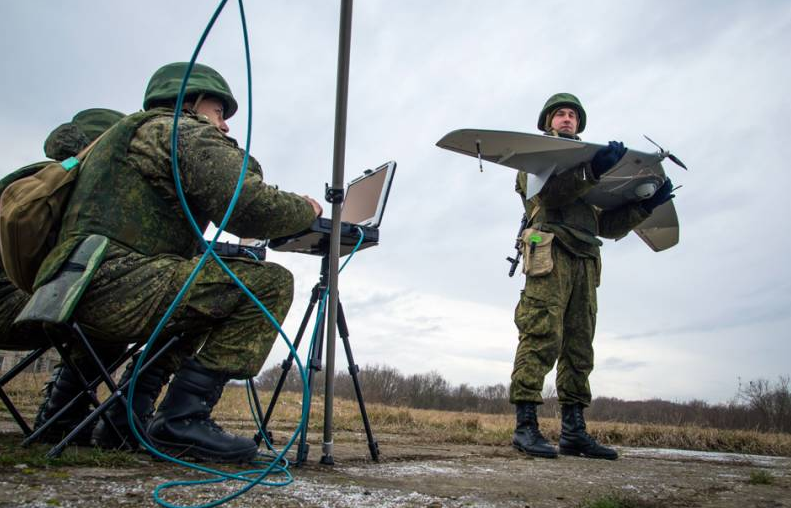
Deliveries of serial reconnaissance complexes "Tachyon" to the troops have been conducted since 2015. There is information that hydrogen fuel cells have been tested on drones of this type. In this case, atmospheric air is used as an oxidizing agent. The use of fuel cells can significantly increase the duration of the flight.
Along with devices like the Granat-4, the most belligerent today are the UAV Orlan-10. This multipurpose drone was created by specialists of the Special Technological Center (STTS) in 2010 year. "Orlan-10" is part of the tactical link management system of the ESU TZ (unified tactical link management system), thanks to which it can broadcast information about the targets to all combat vehicles connected to the combat information system.
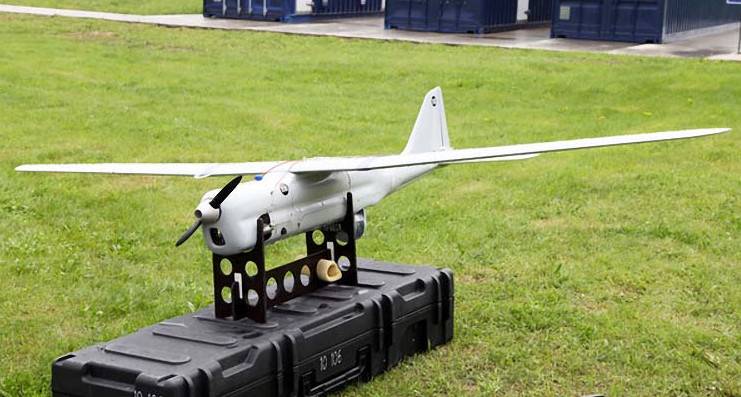
Currently, the UAV "Orlan-10", perhaps, is the most sophisticated Russian lightweight drone. When building the Orlan-10 UAV, a modular architecture was used, which allows changing the composition of the on-board equipment very quickly, as well as transporting the UAV in a disassembled form.
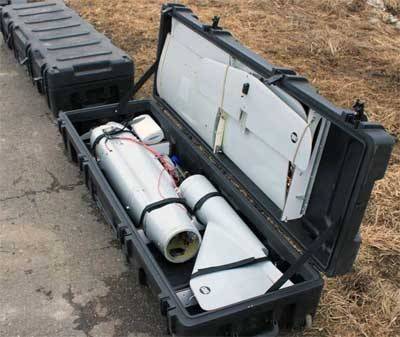
A wide variety of interchangeable payload kits expands the range of possible tasks. On board the drone has its own electric generator, which makes it possible to use energy-intensive equipment: electronic warfare equipment and radio signal repeaters. Components of equipment RB-6В “Leer-341”, designed to suppress enemy ground communications, can be placed as payloads up to 3 kg.
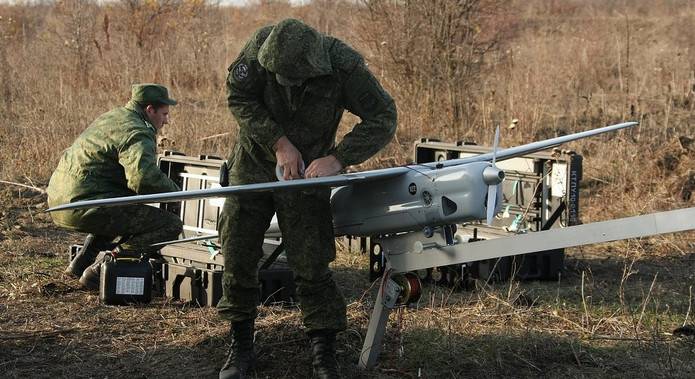
The new version of the Orlan-10 is equipped with high-resolution cameras, which allows you to create high-quality 3D cards and receive and broadcast a high-definition image with the registration of current parameters (coordinates, altitude, frame number). For one departure, the device is capable of surveying the area up to 500 km ². Navigation on the flight route is carried out using an onboard GLONASS / GPS receiver. To control the drone from a mobile ground station, transmit-receive equipment is used, which forms a crypto-protected command and telemetry channel. Video and photo shots from the UAV are also encrypted.
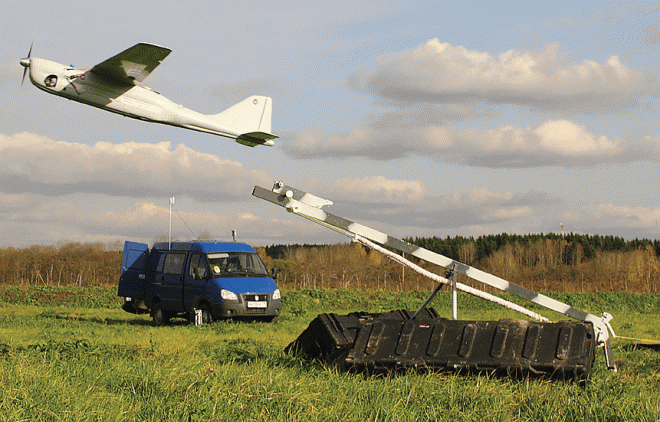
From the control point, it is possible to control the actions of four drones simultaneously at a distance of up to 120 km. Each drone can be used as an intermediate repeater in the transmission of control signals and intelligence information. Although the mass of the device is relatively small (15-18 kg, depending on the modification and set of on-board equipment), it has flight data that fully correspond to the volume of tasks performed by it. The piston petrol engine accelerates the Orlan-10 to 150 km / h. The loitering speed - 80 km / h. If necessary, the Orlan-10 is capable of performing independent reconnaissance raids along a pre-programmed route to a distance of up to 600 km. Duration of non-stop flight - up to 10 hours. Practical ceiling - 5000 m. The launch of the drone comes from a catapult, and landing when returning by parachute.
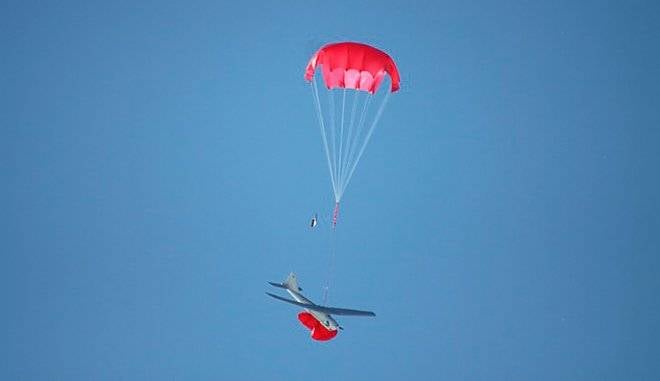
Deliveries of the first UAV "Orlan-10" to the troops began after 2012. Currently, more than 200 vehicles of this type have been supplied to the Russian Army. "Eagle" well recommended during reconnaissance flights in Syria. At the same time, they not only conducted reconnaissance and controlled the accuracy of air strikes, but also issued target designation to Russian combat aircraft, helicopters and artillery systems. Although the Orlan-10 does not carry weapons, according to Western military observers, it is an effective part of the strike complex. A light Russian drone can be used as a system for controlling and adjusting real-time artillery strikes while controlling the 152-mm ACS Msta-S and MLRS receiving UAV coordinates and corrections for projectiles exploded through gyro-stabilized television and infrared cameras.
In a relatively short period of time, Russian specialists have been able to develop and adjust the assembly of remotely-piloted light and ultra-light class vehicles designed for patrolling and intelligence gathering in the near zone. Due to this, in 2014, it was possible to form 14 units of unmanned aerial vehicles, armed with which there were 179 unmanned systems. However, it should be noted that the production of lightweight UAVs is not fully localized in our country, and they include a large proportion of imported components: radioelectronic elements, control systems, large-capacity lightweight electric batteries, computer equipment and software. At the same time, the creation of unmanned vehicles with a range of reconnaissance over 100 km with the transfer of information in real time proved to be a very difficult task. As is known, during the “Serdyukovschiny” period, the leadership of the Defense Ministry of the Russian Federation set a course for the acquisition of foreign models of equipment and weapons. So, according to the Russian Center for Analysis of the World Trade in Arms (TSAMTO), in April 2009, two Israeli middle-class drone Searcher Mk II were purchased for complex tests. The amount of the transaction was $ 12 million. At the time of the sale, this was not the latest Israeli development, but in Russia there were no workable counterparts at that time.
In 2012, the Ural Civil Aviation Plant (UZGA) launched the production of a licensed copy of the IAI Searcher UAV Searcher Mk II. - "Outpost". In 2011, the Ministry of Defense issued a contract to UZGA for the supply of 10 complexes with Forpost UAVs with a total value of 9,006 billion rubles. Each complex has a ground control station and three UAVs.
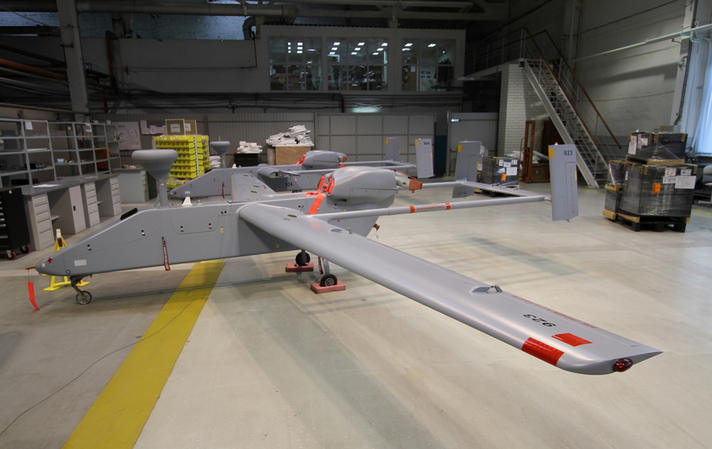
According to advertising information published by the Israeli concern Israel Aerospace Industries, the Searcher II unmanned vehicle (eng. Searcher - Searcher), which made the first flight in the 1998, has a mass of 436 kg and a range of 250 km. The Searcher II has a piston engine UEL AR 68-1000 with a capacity of 83 l. with. with three-bladed pusher propeller. The unit can be airborne for up to 18 hours. Maximum flight speed - 200 km / h, cruising - 146 km / h. Practical ceiling - 7000 m. The take-off and landing of the 5,85 m long device and the wingspan of the 8,55 takes place along an aircraft - onto a three-wheeled chassis. In addition, the launch can be carried out from unprepared sites, using a catapult or solid fuel boosters.
The complex includes a control station, technical support vehicles and a drone 3. As of the end of 2017, 30 complexes were delivered to the troops. During a visit to UZGA by Deputy Minister of Defense Y. Borisov in December 2017, it was announced that in 2019, the assembly of the Forpost UAV would begin entirely from Russian components. According to foreign sources, Forpost, the UAVs, were based at Hmeimim airbase during the military operation of the Russian Aerospace Forces in Syria.
In 2007, at the MAKS-2007 air show, in the exposition of RSK MiG, JSC, the layout of the Skat reconnaissance-impact UAV was presented. When designing the MiG Skat, solutions were put in place to reduce radar and thermal visibility.
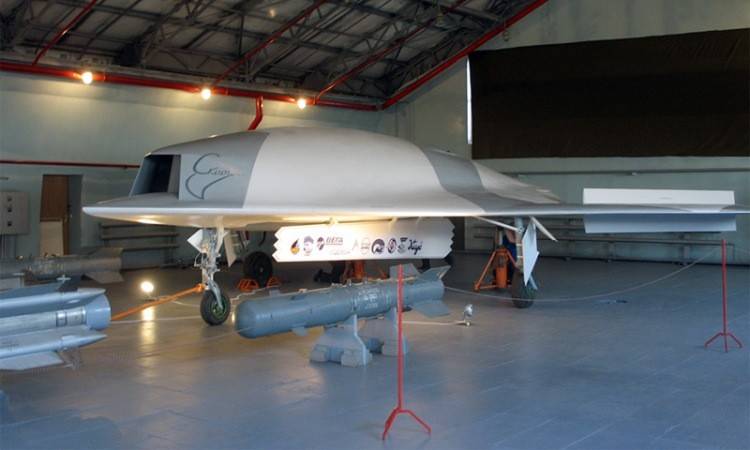
The device with a maximum take-off weight of 10 t was planned to be equipped with TRDDF RD-5000B with a weight of 5040 kgf. Unmanned stealth with a wingspan of 11,5 m was supposed to reach a maximum speed of 850 km / h and have a combat radius of 1500 km. Combat load weighing up to 6000 kg was planned to be placed in the internal compartments and four external suspension nodes. The armament was to include adjustable bombs weighing 250-500 kg and guided missiles X-31 / P and X-59. However, due to lack of funding, a promising project was frozen. Subsequently, the Skatu developments were transferred to the Sukhoi Design Bureau and were used during the design of the C-70 UAV, created by the Okhotnik R & D framework. Design characteristics of this device are unknown. According to expert estimates, its mass can reach 20 t, and the maximum speed is estimated at 1000 km / h.
At the moment, the armament of the VKS of Russia has no strike unmanned aerial vehicles, which, of course, cannot satisfy our military. From 2011 year OKB im. Simonov, together with the Kronstadt group within the framework of the Altius-M project, is developing a heavy (take-off weight 5000-7000 kg) UAV Altair, which, in addition to monitoring the earth and water surface and conducting radio-technical reconnaissance, will be able to carry controlled aircraft lesions. Development of a complex of onboard equipment was entrusted to EMZ them. V.M. Myasishchev. The creation of an unmanned complex from the budget allocated 1 billion rubles.
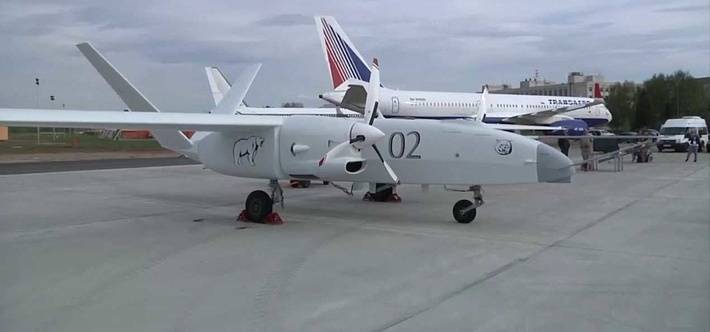
In August, 2016, the information appeared that an experienced copy of the Altair UAV, built on KAPO them. Gorbunova in Kazan, made the first flight. According to information published in open sources, “Altair” can have a flight time of up to 48 hours, overcoming during this time the distance to 10 000 km. The drone can take on a payload of up to 2 and payload to a height of up to 12 000 m. The device’s glider is made of composite materials, its length is 11,6 m, its wingspan is 28,5 m.
Satellite image of Google Еarth: a prototype of the Altair UAV at the KAPO im. Gorbunova in Kazan
The aerodynamic design of the airframe repeats the single-engine middle-class Orion UAV with a range of up to 3000 km, announced by the Kronstadt group. In addition, the power supply system and onboard control equipment are largely unified with the Orion. But unlike Orion, the Altair has two engines located under the wing. The power plant uses two diesel engines RED A03, the production of which is conducted in Germany. The turbocharged diesel-powered liquid-cooled diesel engine has an 500 horsepower take-off power. and weight with gearbox 363 kg.
The avionics of the heavy drone include: an information control system with satellite and radio channels for information exchange, interface equipment with a complex of ground equipment, an on-board equipment monitoring and diagnostics system, an inertial navigation satellite system, an airborne radar system. As a payload can be used various optoelectronic reconnaissance equipment, side-looking radar, as well as adjustable bombs and guided missiles. The complex includes: a control station, an equipment for receiving and transmitting signals, a ground control station for automatic takeoff and landing, as well as two unmanned vehicles. It is expected that the main tests of the Russian heavy UAV "Altair" will be completed in 2020 year. However, as the experience of recent years has shown, the refinement of technically complex projects with a large coefficient of novelty in our country tends to drag on.
Last summer, at the MAKS-2017 air show, the Kronstadt group presented its Orion UAV, developed on the instructions of the RF Ministry of Defense in the framework of the Pacer Pacer. Orion is the Russian equivalent of the MQ-1 Reaper UAV and looks like it. The tender for the development of the Intermediate-Range Unmanned Aircraft Complex (BAK SD) “Pacer” was announced on October 14 of the year 2011. The companies Tupolev and Vega also participated in it.
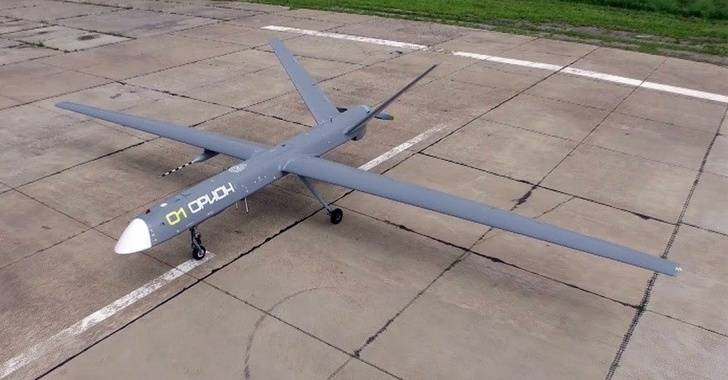
Like the MQ-1 Reaper, the Russian Orion UAV is a mid-wing aircraft with a large elongation wing, a V-shaped tail assembly and an engine with a pusher propeller located in the tail section. The two-bladed screw AB-115 with a diameter of 1,9 meter is driven by a four-cylinder petrol turbocharged engine Rotax 914 with a power 115 hp. In the future, it is planned to use engines manufactured in Russia APD-110 / 120. After takeoff, the drone's chassis are removed. It is assumed that the maximum duration of the flight of the Orion BLA with a take-off weight of about 1200 kg will be at least 24 hours, and the ceiling - 7500 meters. Payload Mass - 200 kg. Speed - 120-200 km / h.
In the forward part of the apparatus there is a sight-seeing gyro-stabilized optical-electronic system developed by the Moscow company NPK NGN on the Argos platform, supplied by DS Optronics - the South African branch of the Airbus concern. An optoelectronic system consisting of two thermal imaging cameras with a variable angular field, a wide-angle television camera and a laser range finder-target designator is capable of detecting and tracking in automatic mode and targeting to use a guided weapon. In the central compartment can be placed interchangeable platforms with digital cameras: a surveillance radar, which is closed by a large radio transparent fairing, or a passive radio intelligence station, designed to collect information about enemy air defense systems.
During the Army-2017 forum, held in August 2017, the OKB Aviaavtomatika and Vais-Tekhnika companies for the first time demonstrated 25-50 kg guided bombs that were tested on the Orion UAV. Three different variants of bombs have a laser, television and guidance on the signals of the satellite positioning system.
According to information published in the media, flight tests of the first prototype of the Orion UAV were launched in the spring of 2016. It is known that in the summer and autumn of 2016, the prototype of the device was tested at the airfield of LII named after M.M. Gromov in Zhukovsky. Compared with other unmanned aerial vehicles in service with the Russian Army, the Orion UAV is certainly a significant step forward. But it should be understood that according to its flight data, it generally corresponds to the UAV MQ-1 Reaper. In December 2016, the US military decided to abandon the continued operation of the outdated "Predator" and completely replace it with the MQ-9 Reaper UAV with a 910 hp turboprop engine. The Grim Reaper has a maximum flight speed of more than 400 km / h, a combat load of up to 1700 kg and a range of more than 5000 km. Thus, despite some progress in the development of unmanned aircraft, our country still remains in the role of catch-up.
Based on:
https://militarizm.livejournal.com/51079.html
http://zonwar.ru/news/news_110_Tu-141_Strish.html
http://www.arms-expo.ru/articles/124/81839/
http://aviation21.ru/3582-2/
http://rusvesna.su/news/1406935390
http://nevskii-bastion.ru/tu-243-maks-1999/
https://defendingrussia.ru/enc/bpla/tu143_krylataja_raketarazvedchik-1531/
http://www.arms-expo.ru/049055055056124052052048048.html
https://militarizm.livejournal.com/51079.html
https://vpk.name/library/reys-d.html
http://www.razlib.ru/transport_i_aviacija/aviacija_i_kosmonavtika_2004_01/p3.php
http://todaysmilitary.ru/2016/01/21/vnutri-tajnoj-programmy-bpla-severnoj-korei/
https://www.globalsecurity.org/military/world/russia/aircraft-uav.htm
https://bmpd.livejournal.com/2587680.html http://www.navaldrones.com/Searcher-II.html
https://sdelanounas.ru/blogs/93663/
https://sdelanounas.ru/blogs/100018/
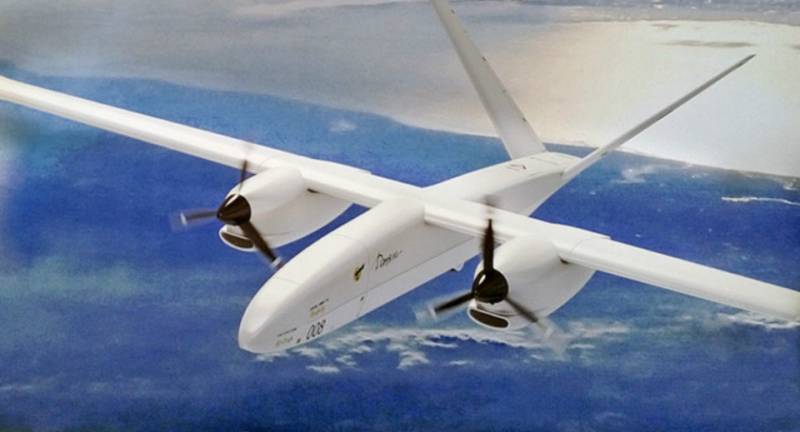
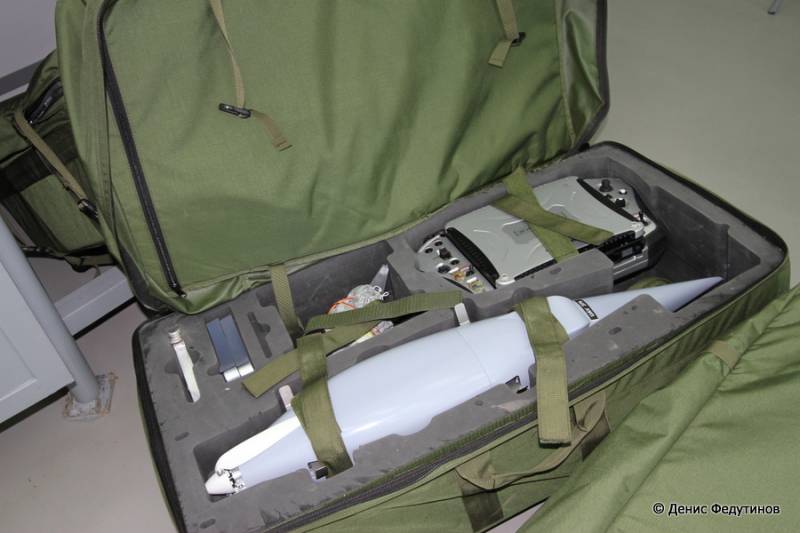
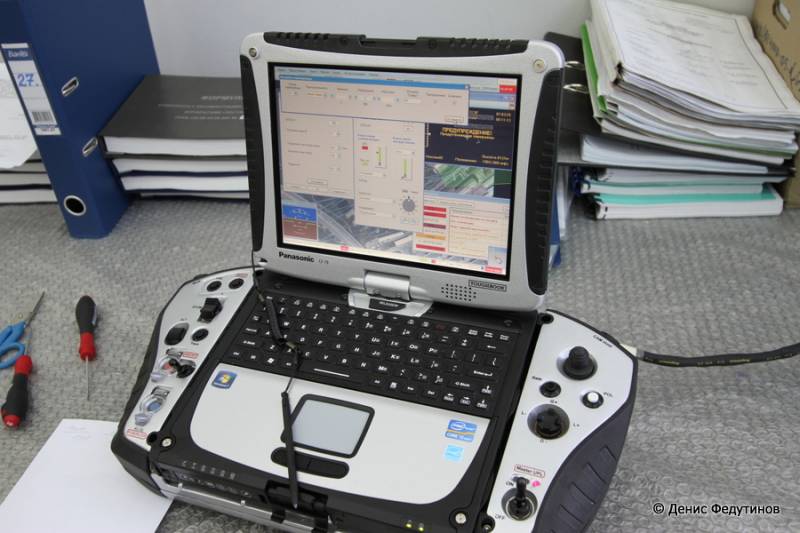
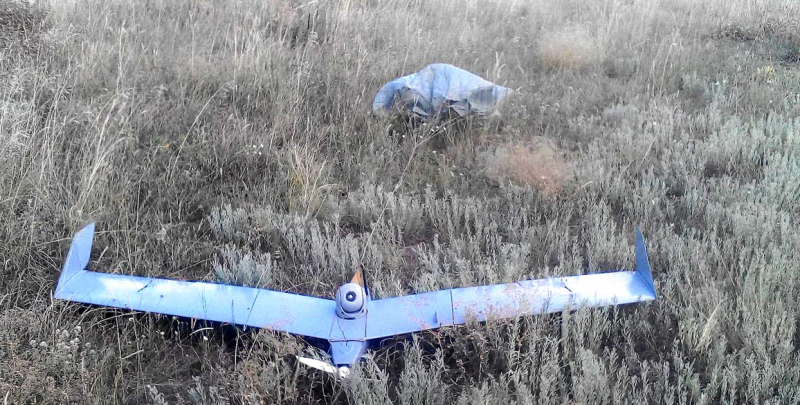
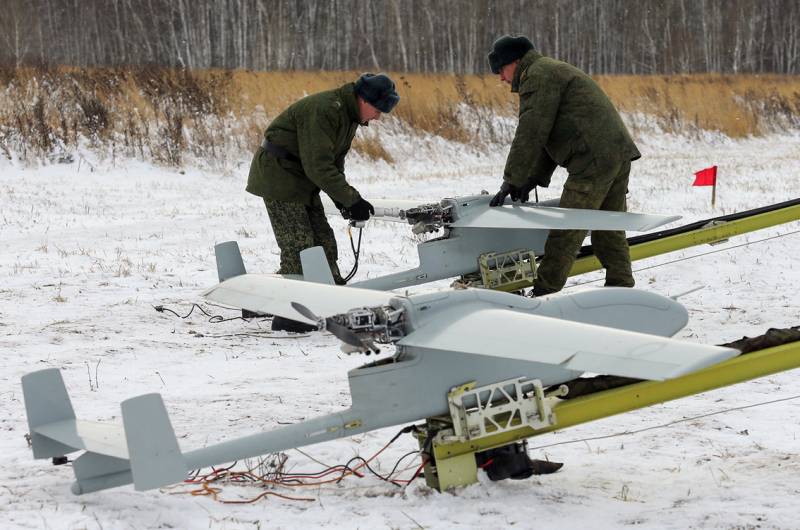
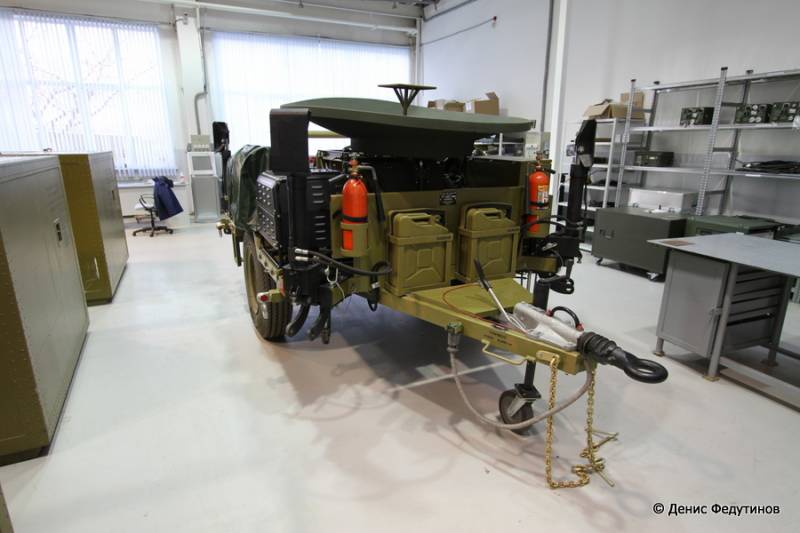
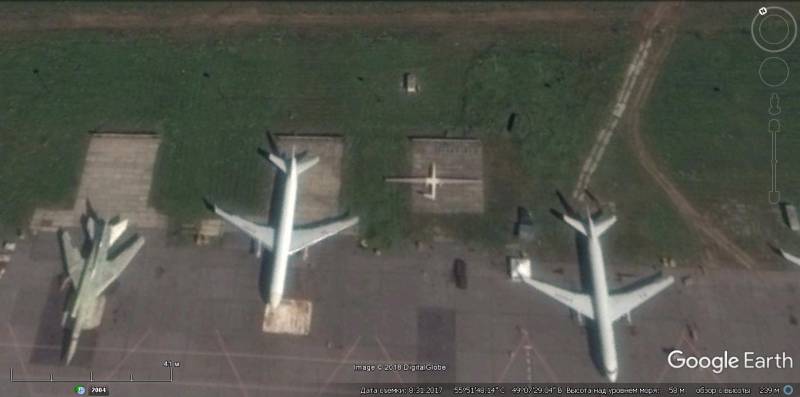
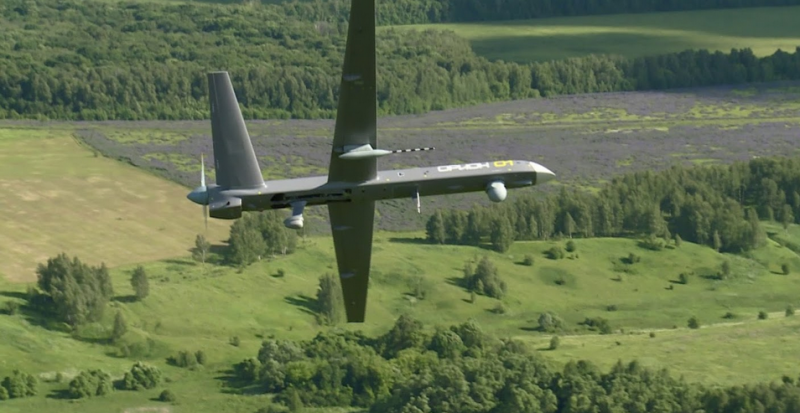
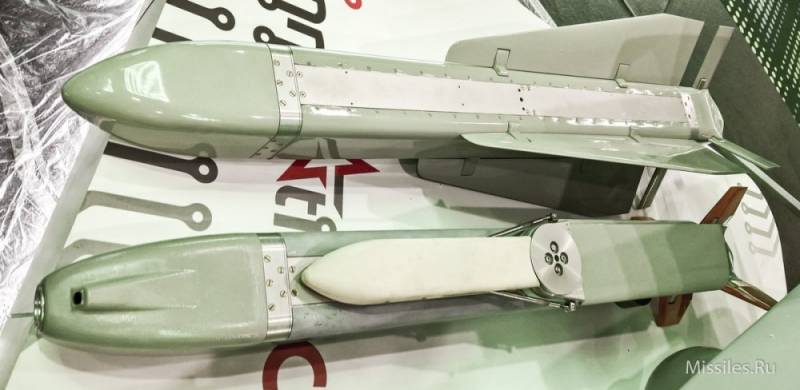
Information